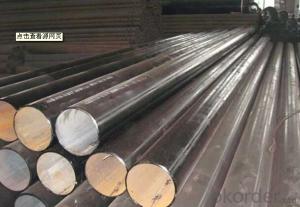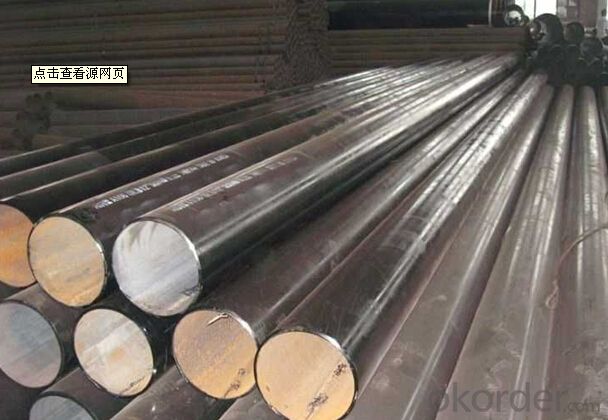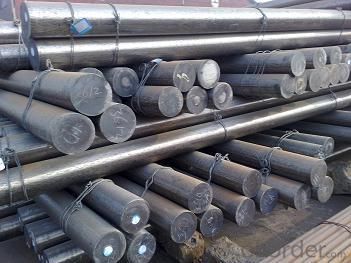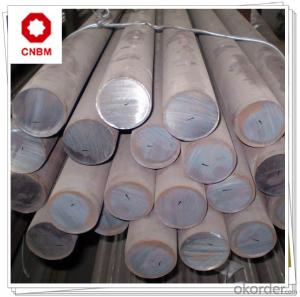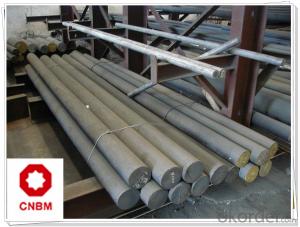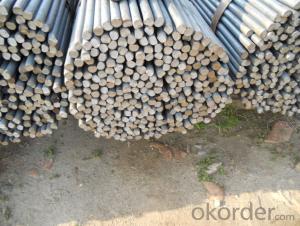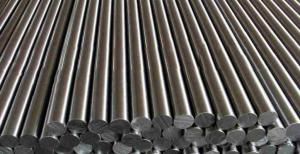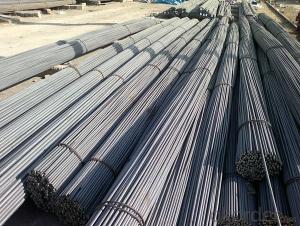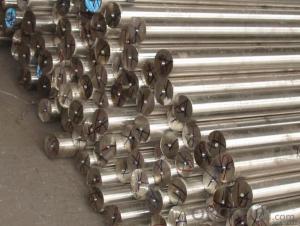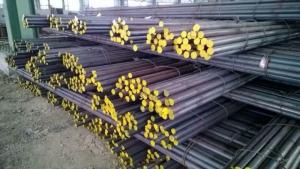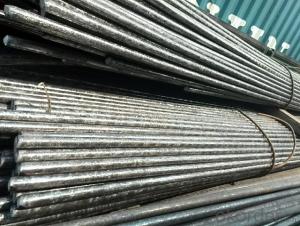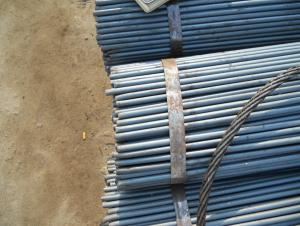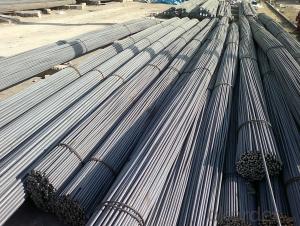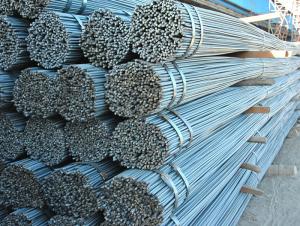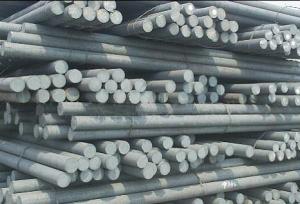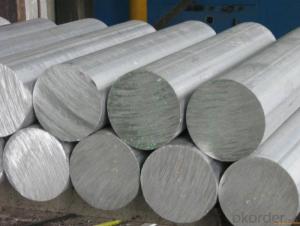Hot Rolled Steel Round Bar For Pipes Produce
- Loading Port:
- China main port
- Payment Terms:
- TT OR LC
- Min Order Qty:
- 25 m.t.
- Supply Capability:
- 5000 m.t./month
OKorder Service Pledge
OKorder Financial Service
You Might Also Like
Grade | AISI 52100, ASTM E52100, DIN 1.3505,JIS SUJ2, GCr15 |
Dimensions | Diameter: 30-60mm Length: 2000-13000mm or as required |
Shape | Round Bar |
Type | Alloy Steel Bar |
Delivery Condition | Black Surface |
Material | Bearing Steel |
Technique | Hot Rolled |
Usage and Applications
These steels are used for ball and roller bearing applications and are comprised of low carbon steels and high carbon through harden able steel.
First the famous 1C-1.5Cr steel from which the majority of bearings are made. Its structure is apparently well-understood and the focus is on purity in order to avoid inclusions which initiate fatigue during rolling contact. Then there is the M50 steel and its variants, from which bearings which serve at slightly higher temperatures in aeroengines are manufactured, based on secondary-hardened marten site.
Tapered roller bearing are generally used to support combined load mainly consisting of radial load. Their cups are separable for easy assembling ,During mounting and using, radial clearance and axial clearance can be adjusted and preloaded mounting can be made.
Packaging & Delivery
Packaging Detail: ASTM 52100 Steel in seaworthy packing or on customer request; Packed in bundles with standard export sea-worthy package or as customer require
Delivery Detail: 45 days after confirmed
Trade terms: FOB, CFR, CIF ou as customer's required
MOQ: 25 tons or at customer's demands. If the quantity is good, the price will be better.
Processing of Bearing Steel Round Bar
The processing of Bearing Steel Round Bar is hot rolled (strictly control sulphur, phosphorus and non-metallic inclusions content and distribution)
Chemical Composition of Bearing Steel Round Bar
C | Si | Mn | Cr | Ni | Cu |
Equal or less than | |||||
0.95-1.05 | 0.15-0.35 | 0.25-0.45 | Cr:1.40-1.65 | 0.30 | 0.25 |
All products' chemical composition and specification can be design according to customers' requirement.
Note
1. According to national standard (GB) for our products, if not, supply according to national standards (GB) or agreement.
2. We can not only provide electric furnace +LF+VD and electros lag re-melting (ESR) steel forging materials, but also forging products of piece, bar, etc.
3. Our company is equipped with roll equipment and can provide our customers with roll billets or finished.
4. Please send us your detailed specifications when inquire. We will reply to you ASAP.
5. Certificate of quality is issued in English, in addition the normal terms, production process, the mechanical property (yield strength, tensile strength, elongation and hardness. forged ratio, UT test result, Grain size, heat treatment methods and the sample of is shown on the certificate of quality.
- Q: What is the difference between seamless and welded steel round bars?
- Seamless and welded steel round bars differ primarily in the manufacturing process and the resulting characteristics of the final product. Seamless steel round bars are manufactured by piercing a solid billet of steel to create a hollow tube. This tube is then elongated and further processed to achieve the desired dimensions and surface finish. The seamless manufacturing process ensures that there are no welds or joints along the length of the bar. As a result, seamless steel round bars have a uniform composition and structure throughout, providing excellent strength and reliability. They are often preferred when high pressure or high-temperature applications are involved, as they offer better resistance to internal and external pressure. On the other hand, welded steel round bars are made by joining two or more pieces of steel together through welding techniques. This involves heating the ends of the steel pieces and fusing them together using various welding methods, such as arc welding, resistance welding, or fusion welding. The welding process introduces a weld seam along the length of the bar, which can affect its structural integrity and mechanical properties. Welded steel round bars may have slightly lower strength and toughness compared to seamless bars, as the presence of the weld seam can create stress concentrations. However, they are generally more cost-effective and readily available in a wide range of sizes and grades. In summary, the main difference between seamless and welded steel round bars lies in their manufacturing process and resulting characteristics. Seamless bars are produced by piercing a solid billet, offering uniform composition and strength throughout, making them suitable for high-pressure and high-temperature applications. Welded bars, on the other hand, are created by joining multiple pieces of steel through welding, introducing a weld seam that can slightly affect their strength and toughness. Welded bars are often more cost-effective and readily available in various sizes and grades.
- Q: Can steel round bars be used in the production of power tools?
- Yes, steel round bars can be used in the production of power tools. Steel is a durable and strong material that is commonly used in the manufacturing of various tools and machinery, including power tools. Steel round bars can be used to create the body, handles, and other components of power tools, providing stability, strength, and longevity. The steel used in power tools is often selected for its high tensile strength and resistance to wear and tear. Additionally, steel can be easily machined, allowing for precise shaping and customization of power tool components. Overall, steel round bars are a suitable choice for the production of power tools due to their strength, durability, and versatility.
- Q: Are steel round bars suitable for use in food processing equipment?
- Steel round bars are not suitable for use in food processing equipment. This is because food processing equipment necessitates materials that can resist corrosion, are easy to clean, and do not react with food substances. Although steel round bars are strong and durable, they have a tendency to rust and can potentially contaminate food with metallic particles. On the other hand, stainless steel is the ideal choice for food processing equipment due to its high resistance to corrosion, ease of cleaning, and non-reactive properties. It is crucial to prioritize the safety and hygiene of food processing equipment, which is why steel round bars should not be utilized in this context.
- Q: What is the difference between a cold finished and a hot rolled steel round bar?
- A cold finished steel round bar and a hot rolled steel round bar differ in their manufacturing processes and resulting properties. Cold finished steel round bars are manufactured through a cold drawing process, where the steel is pulled through a die at room temperature. This process results in a smooth, polished surface with tight dimensional tolerances. The cold drawing process also enhances the strength, hardness, and overall mechanical properties of the steel. Cold finished steel round bars are often preferred for applications where precision and a smooth surface are crucial, such as in machinery, automotive parts, and tools. On the other hand, hot rolled steel round bars are manufactured by heating the steel to a high temperature and then rolling it through a series of rollers. This process allows for the shaping and forming of the steel while it is in a pliable state. Hot rolled steel round bars have a rough, scaled surface and looser dimensional tolerances compared to cold finished bars. They also tend to have a slightly lower strength and hardness than their cold finished counterparts. Due to their more affordable cost and ease of production, hot rolled steel round bars are commonly used in construction, structural components, and general fabrication. In summary, the main differences between cold finished and hot rolled steel round bars lie in their manufacturing processes and resulting properties. Cold finished bars offer enhanced strength, precision, and a smooth surface, making them suitable for applications requiring high precision and mechanical performance. Hot rolled bars, on the other hand, have a rougher surface and looser tolerances, but their affordability and ease of production make them a popular choice for general applications.
- Q: What are the different types of steel round bar surface treatments used in the automotive industry?
- In order to enhance the performance, durability, and aesthetics of components in the automotive industry, various surface treatments are utilized for steel round bars. Some commonly employed treatments include: 1. Phosphating: Widely used, this treatment involves the application of a phosphate coating onto the steel round bar. Its purpose is to improve corrosion resistance and establish a suitable foundation for further coatings or paints. 2. Galvanizing: Another method is to apply a layer of zinc onto the surface of the steel round bar. This treatment offers excellent corrosion resistance and extends the lifespan of the component. 3. Electroplating: By utilizing an electric current, a thin layer of metal, such as chrome or nickel, is deposited onto the steel round bar's surface. This treatment enhances appearance, provides corrosion resistance, and improves wear resistance. 4. Powder coating: A popular technique involves the application of a dry powder onto the surface of the steel round bar, followed by heating to form a protective coating. This treatment ensures exceptional durability, corrosion resistance, and can be customized with different colors and finishes. 5. Anodizing: Typically used for aluminum components, anodizing can also be applied to steel round bars in specific cases. This treatment involves the creation of an oxide layer on the surface, resulting in improved corrosion resistance and enhanced appearance. 6. Black oxide coating: A chemical treatment that produces a blackened surface on the steel round bar. This treatment offers corrosion resistance, improved aesthetics, and can serve as a lubricant in certain applications. It is crucial to consider the specific requirements of the automotive component, including environmental conditions, desired appearance, and functional properties when selecting the appropriate surface treatment. Manufacturers meticulously choose the most suitable treatment to ensure optimal performance and longevity of steel round bars in the automotive industry.
- Q: How do you prevent steel round bars from rusting?
- To prevent steel round bars from rusting, there are several effective methods you can employ: 1. Apply a protective coating: One of the most common ways to prevent rust on steel round bars is to apply a protective coating. This can be done by using paint, epoxy, or other corrosion-resistant coatings. The coating acts as a barrier between the steel and moisture, preventing oxidation and rust formation. 2. Keep the bars dry: Moisture is a major catalyst for rust formation. Therefore, it is important to keep the steel round bars dry at all times. Store them in a dry location, away from water or humidity. If the bars come in contact with water, make sure to dry them thoroughly to prevent any residual moisture from causing rust. 3. Implement proper ventilation: Adequate ventilation helps in reducing moisture levels in the air, which in turn prevents rusting. Ensure that the storage area or facility where the steel round bars are kept has good airflow and is well-ventilated. This will minimize the chances of moisture buildup and rust formation. 4. Apply corrosion inhibitors: Corrosion inhibitors are chemical compounds that can be applied to the surface of steel round bars to prevent rust. These inhibitors work by forming a protective layer on the steel, inhibiting the oxidation process. There are various types of corrosion inhibitors available, so choose the one that is suitable for your specific application. 5. Regular maintenance and inspection: Regularly inspect the steel round bars for any signs of rust or damage. If any rust spots are found, remove them immediately using a wire brush or sandpaper and apply a fresh coat of protective coating. Additionally, ensure that the bars are stored in a clean and dry environment to minimize the risk of rust formation. By following these preventive measures, you can significantly reduce the chances of steel round bars rusting and prolong their lifespan.
- Q: What are the environmental benefits of using steel round bars?
- There are several environmental benefits of using steel round bars. Firstly, steel is a highly recyclable material, which means that using steel round bars can help reduce the demand for new raw materials and decrease the amount of waste sent to landfills. Additionally, steel production processes have significantly improved in recent years, resulting in lower emissions of greenhouse gases and air pollutants. Steel is also durable and long-lasting, reducing the need for frequent replacements and saving valuable resources. Overall, the use of steel round bars can contribute to a more sustainable and eco-friendly construction industry.
- Q: What is the minimum diameter available for steel round bars?
- The specific manufacturing and supplier capabilities can cause variations in the minimum diameter of available steel round bars. Typically, a wide range of diameters can be found, starting from as small as 1/8 inch (3.175 mm) and going up to several inches or even larger. To ascertain the exact minimum diameter for steel round bars that aligns with your specific needs, it is advisable to consult with steel suppliers or manufacturers.
- Q: Are steel round bars resistant to fire?
- Yes, steel round bars are highly resistant to fire. Steel is a non-combustible material and has a high melting point, making it suitable for use in high-temperature environments.
- Q: Can steel round bars be used for making suspension springs?
- Yes, steel round bars can be used for making suspension springs. Steel is a commonly used material for suspension springs due to its high strength and durability. The round bars can be forged or shaped into the desired spring shape and then heat-treated to achieve the desired spring characteristics. Additionally, steel round bars can be easily machined and drilled to accommodate different suspension systems and components. However, it is important to consider the specific requirements and load capacity of the suspension system to ensure that the chosen steel round bars are suitable for the intended application.
Send your message to us
Hot Rolled Steel Round Bar For Pipes Produce
- Loading Port:
- China main port
- Payment Terms:
- TT OR LC
- Min Order Qty:
- 25 m.t.
- Supply Capability:
- 5000 m.t./month
OKorder Service Pledge
OKorder Financial Service
Similar products
Hot products
Hot Searches
Related keywords
